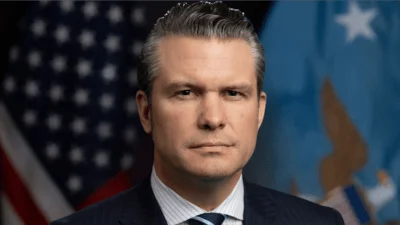Thank you, and good morning everyone. I'm pleased to have this opportunity to meet with you. (In my earlier corporate career, we did a little business with some of your members).
Today, I want to talk with you about immigration.
Let me tell you up front, President Bush remains committed to comprehensive reform because border security alone will not solve this country's immigration problems.
We appreciate the workload facing the Congress in the next few weeks and the important national security issues that demand their attention, but we urge them to make progress toward comprehensive immigration reform.
I know this is a critical issue for you. I know that seasonal migrant workers have played a crucial role in supporting American agriculture.
I believe immigration is the domestic social issue of our time--and a key to our future economic health.
America has dealt with difficult immigration issues in the past. There have been large waves of immigrants from Asia, Western Europe, and Eastern Europe, throughout our history.
In fact, proportionately, we have fewer foreign-born people living in the United States today than we did in 1890. In 1890, 14.8 percent of our population was foreign-born. In 2004, 12 percent was foreign born.
So, the challenges of immigration are not new for America, and I believe they create tremendous opportunities.
We are competing in a global economy. Many countries, including Germany, China, and Japan, will face declining populations in the future.
Population All major industrial economies are experiencing substantial growth in their population aged 65 and over. By 2025, the median age of German citizens will increase from 39 to 50 years old. Japan will also see a 46 percent growth in this age group by 2020.
The U.S. will also see our median age growing from 34 to 43. And every11 seconds, a baby boomer turns 60.
But what separates us from other nations is our ability to assimilate immigrants and incorporate them into our workforce.
From 2000 to 2004, the U.S. Census Bureau estimated that total U.S. population grew by more than 12 million. 44 percent of the growth resulted from immigration.
We have an incredible advantage. We can stand out from the pack by using our well-honed skills from 230 years of assimilating immigrants.
But to address the challenges of illegal immigration, take advantage of the opportunities, and strengthen our country for the rest of the century, we must show leadership.
We must face reality. We must deal with immigration as it is, not as we wish it were. We must thoughtfully work through the issues, and avoid letting emotion take over the debate.
I am encouraged that we are starting to reach some consensus: The reality is that we have jobs that American citizens either aren't willing to or aren't available to do.
Our unemployment rate is below the average of the past four decades. I continually hear from industries that they are having difficulty finding workers.
A lack of foreign labor is hurting the Florida citrus industry where millions of boxes of oranges may not be picked this season.
In California, the on-going worker shortages due to the heightened security at the Mexican border, combined with the late growing season, have kept the number of hired workers below last year.
Fields in Santa Cruz County in California are being abandoned because farmers can't find enough workers.
Last month, the Associated Press reported that the lack of workers is so bad that one farmer in California has been forced to tear out nearly 30 acres of vegetables, and has about 100 acres compromised by weeds.
Immigration reform must provide a legal means to meet labor needs. According to the American Farm Bureau, without comprehensive immigration reform: 1. Priority number one in the President's comprehensive proposal is securing our borders.
The President has proposed: Already the number of captured illegal immigrants has fallen by 45 percent since spring -- as fewer crossings are attempted during a normally high-volume season.
And there's been a 7 percent drop in immigrant deaths in the desert, compared with last year.
Clearly, the message is out that we have stepped up security at our border.
One of the best ways to secure our borders is to have immigration enforcement inside our country -- in the interior.
2. We need effective interior enforcement. That may be the best way to secure our borders.
Our system needs to be fixed.
We have an underground industry built on producing false documentation for illegal workers.
Employers have a hard time helping enforce the law because they are not sure what documents they should require.
With comprehensive reform, we will ensure that businesses have the tools they need to do this, and that we can hold them accountable.
That's why we need a temporary worker's program. It would create a legal means for workers to enter the United States for a limited time.
And we need a biometric card identification system.
We have the technology today to quickly and effectively use a person's unique characteristics, such as a fingerprint, to verify immigration status so we know who is in the country, why they are here and where they are working -- all of which are critical to security.
When we have a biometric system -- and we have a temporary worker's program -- dynamics will change.
Over time, it will become unlikely that people will risk their lives coming across the border illegally if it is well-known that unless you have the temporary worker's permit, you will not find a job.
This is one of the most consequential things we can do to make our borders more secure. And it demonstrates the wisdom of comprehensive immigration reform.
3. The other reality we must confront is that we have 12 million people who are in the country illegally. This issue will not be resolved by ignoring it, or waiting longer to confront it.
Think about the task of deporting 12 millions individuals. Is that something we are going to do as a country? The President has said it wouldn't be wise, practical, or humane.
It would require separating parents from their 3 million American-born children. Some say the children could decide if they go with their parents or stay. Can you imagine that? Mass deportation is an extreme position, and it's not realistic.
The other extreme is amnesty. The dictionary defines amnesty as an "unconditional pardon -- obliterating all memory of the offense." The President does not support amnesty. It's not accurate or fair to call his solution amnesty. He believes that there must be consequences for those who violate our laws.
We're talking about having a hard-earned path to legalization, which would require meeting conditions: What we need is leadership and reasonable compromise in the middle. We need to be talking about the right mix of immigration reform that addresses all the issues -- and acknowledges that extremes aren't viable.
Hutchison-Pence proposal Senator Kay Bailey Hutchison and Representative Mike Pence offered an intriguing proposal.
It provides for strong border security, while also recognizing our economy's need for temporary workers.
Their proposal acknowledges that we must secure our borders to secure our nation. The President has already taken bold steps in this direction.
Obviously, there are many details to be worked out. I met with Senator Hutchison and Congressman Pence, and they both believe their proposal is a starting point. We encourage the House and Senate to continue talking, and to continue this rational approach to finding solutions.
4. The other important point that President Bush makes is that we are a nation of immigrants.
And immigrants have helped make this country great. All of us here today -- unless you are Native American -- are immigrants or descendents of immigrants.
I'll give you my personal perspective: I came to this country in 1960 from Cuba. I was a six-year-old immigrant. On January 4, 1966, I formally became a U.S. citizen. To this day, my U.S. passport is my most valued material possession.
I'm extremely grateful that people encouraged -- even pushed me -- to learn the language and assimilate.
I'm also very thankful for the opportunities this country has given me. I believe that immigrants today just want an opportunity.
It is a false choice to think the immigration debate is a battle between America being a welcoming society and being a nation of laws.
We can be both because we are both.
Let me encourage each of you to continue to be an active and vocal participant in this debate. We all need to contribute to the solution.
Comprehensive immigration reform will make our country stronger, and I'm convinced that future generations will be proud of what we did.
Thank you, and God bless you.
Source: U.S. Department of Commerce







